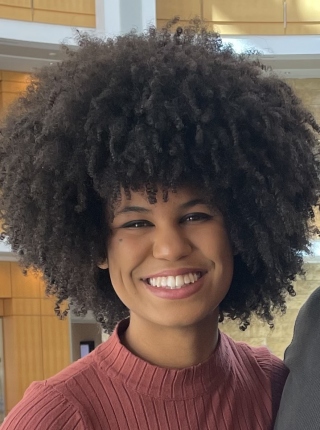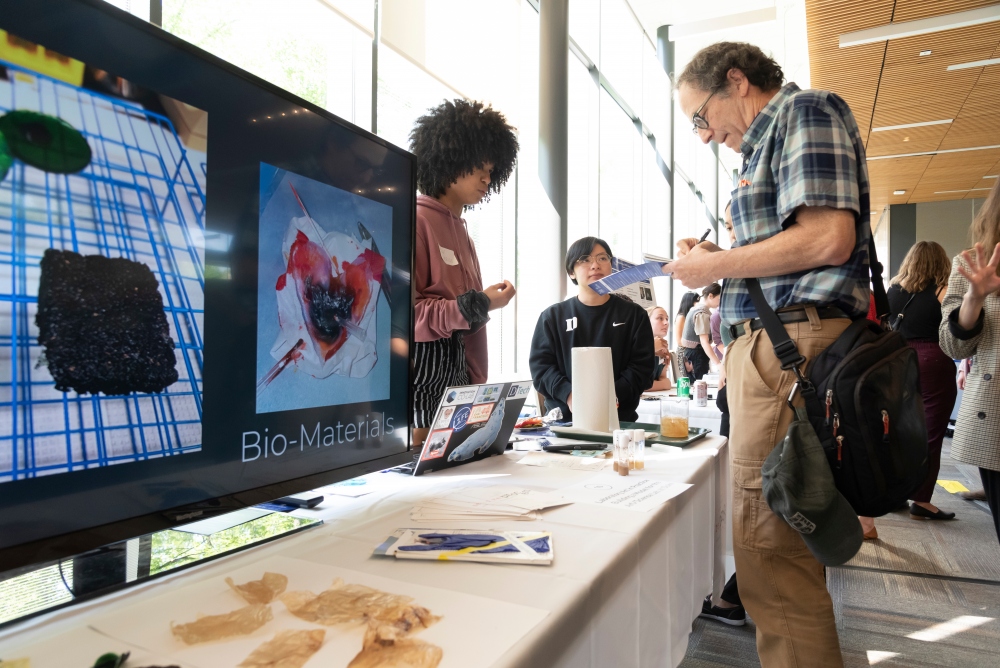Noelle Garrick

The work we did was at times challenging and confusing, but overall important in creating space for experimental projects that do not fit cleanly into a single department.
Degree
Computer Science and Visual Arts ’24Project Team
I applied to Duke as a double major in Computer Science and Visual Arts with a focus on virtual and augmented reality development. Working in game design engines or constructing interactive landscapes infused with custom logic and complemented by conceptual art, 3D models and soundtracks energizes me like nothing else. While I am excited about the growth of Duke’s art initiatives, I encountered a scarcity of practical courses that would allow me to explore media design and more experimental scientific-artistic practices. It was during a search for suitable outlets that I found Laboratory Art in Practice, a Bass Connections project led by professors Mark Olson, Nina Sherwood and Kristen Tapson.
“What is art? What is science? Are they two opposing things or are there similarities between them?” This was the question posed by Professor Olson as he drew two large circles up on the board, labeling each with the aforementioned disciplines. He invited us to fill them with different words and associations we had from our classes at Duke and beyond.
There is a misconception that art lacks the structure to be considered methodological and that science is too rigorous to leave enough room for true creativity. I fundamentally believe they are complementary areas of study, and this Bass Connections team dedicated to working at this intersection quickly became one of my favorite classes at Duke. I found not only a community of individuals who shared similar interests but also a supportive structure for engaging in projects that aligned with my curiosities.

The newly formed et al lab has the goal of developing criteria for practicing “art-science,” which primarily involves artistic documentation of scientific practices and research with more conceptual and abstract outputs. The first semester of the lab dealt in exploratory methods, and the second followed an extended project-based workshop to develop our own exhibit.
In the first semester, we tried many experimental techniques and mediums that were hybrids between art and science, with a focus on personal investigation, accessibility and sustainability. In a bioplastics lab, we worked with different types of biodegradable binding agents to make plastic compounds that we molded into tools and sculptures.
For another, we designed speculative instrument blueprints; I 3D-modeled an aquatic environment that functioned as a biomarker device. In other weeks, we built foldscopes — compact-cost-effective microscope devices — and created agar art, painting with vivid mold cultures. We were encouraged to document observations and insights around these practices in a lab notebook. In working with these unconventional mediums, we gained a new understanding and appreciation of both art and science.

The second semester was an extended, project-based workshop class culminating in a final exhibit showcase at the end of the year. It was rewarding to display my work with my teammates after a long semester of planning, building and critiques. I designed an augmented reality installation juxtaposing live plants and animated 3D model counterparts.
I wanted to explore the mediation between the digital and the natural and how viewers felt about the transition to more digital ways of being. Did they even notice the change or miss the diminishing presence of flora in our lives? Did viewers feel a sense of apprehension or playfulness towards the virtual plants? What are the ethics of this medium as a digital archive? Additionally, I wanted to showcase augmented reality as a valid tool for engagement in this context. The exhibit provided a platform for me to engage with many interesting people and I felt a sense of satisfaction and unity with the final setup. The valuable feedback, questions, insights and critiques I received will be helpful for future projects.
One of the biggest challenges I faced was designing the physical exhibit components. All my work lives on the virtual plane and I had never planned a physical installation before. I have a new appreciation for the interplay between the two aspects. Conceptualizing a layout that complemented the models and subsequently collecting materials was more difficult than expected. Our teaching assistant, Sherly, reminded me that “the exhibit is always a work in progress,” and this allowed me to take pride in its current iteration while also focusing on future enhancements.
I am thankful for the opportunity to work with this team and lay the groundwork for something new at Duke. The work we did was at times challenging and confusing, but overall important in creating space for experimental projects that do not fit cleanly into a single department.
Looking to the future, I am excited for the continuation of the et al lab. It is intended to be a collaborative space that we can revisit, and I am excited to develop a new exhibit that builds upon everything I have learned from this past year.
June 2023
